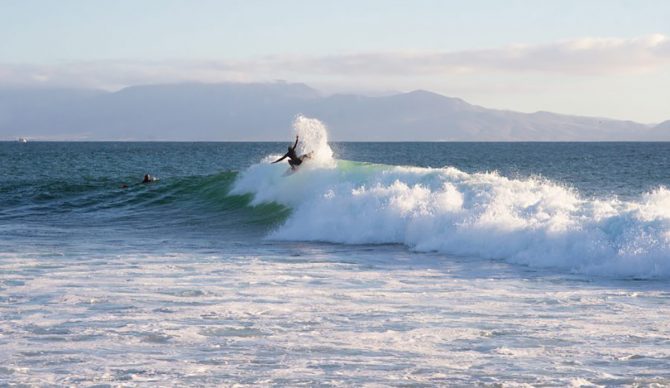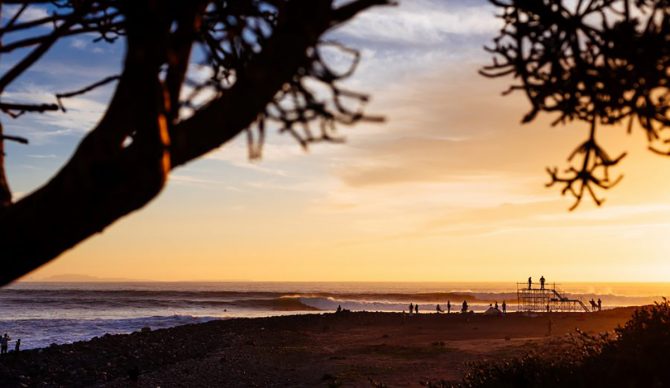
Tres Emes has its day and is a special spot for Ensenada locals. Photo: Nacho Felix//Save the Waves
Surfers of Ensenada, Mexico are pushing back against a new fish hatchery and nursery being built on the bluff of the surf spot, ‘Tres Emes.” With construction already underway, local surfers and organizations are voicing their concerns about the detrimental impact the project could have on both the surf spot and the ecosystem.
The facility will produce striped bass – a fish that is native to the Atlantic coastline of North America. The company behind the project is Pacifico Aquaculture. They have commissioned another company, Billund Aquaculture, to design and build the facilities on the bluff above Tres Emes, as well as “grow out” sites 20 kilometers from the coast where the fish are transferred when they reach 80 grams in weight. The site’s production capacity will be eight-million fish per year.
The opposition groups to the project – most notably Mexican environmental groups Coalición por el Sauzal and Nosotras y el Mar, and the Baja California Surfing Association – have been creating social media campaigns to raise awareness. Their long list of worries include excessive amounts of water that will be released from the facility into the surf zone, removal of native vegetation, decreased access to one of the last remaining publicly accessible surf spots in the area, and the danger of a non-native, invasive fish species escaping into the ecosystem.
Local scientists, oceanographers, and environmental lawyers have reviewed documents provided by Pacifico Aquaculture. One of their principal concerns is the construction of a pipe that will pump out brackish water into the ocean two degrees warmer than the ocean temperature. They estimate about 1,171,000 liters of water per day will be ejected into the Tres Emes lineup.
Among the concerned local surfers is Gino Passalacqua, a Ph.D. in Oceanography who is the scientific advisor for Save the Waves. He’s worried that the pipe could be dangerous for surfers and permanently alter the wave.
“We still don’t know the exact location of the pipe and the construction methodologies that they’ll use,” said Passalacqua. “That’s really worrisome for everyone. That amount of water is definitely going to create changes in density. That could affect the dynamics of the sediment flow that creates the break. On a good day (Tres Emes) is better than Lower Trestles. Having those pipes is a risk.”
Another strong point of contention is the seemingly inevitable escape of fish into the ecosystem. In 2020, concerned citizens wrote a letter to Mexico’s Secretary of the Environment and Natural Resources that claims an environmental impact study regarding the project “presents false and incomplete information.” Specifically, the letter points out that, while it is true striped bass were introduced to the San Francisco Bay in the late 1800’s, there’s no evidence that the species is currently found in the Pacific Ocean of Mexico.
Once the fish are large enough they will be moved to grow-out sites, which are essentially floating cages. According to sources, there will be eight of these cages with diameters of up to 45 meters near Todos Santos islands off Ensenada. In the letter, the citizens underline that the islands are part of a national marine reserve (also a World Surfing Reserve) and the introduction of an invasive species would be counterproductive to the mission of protecting the area.
According Nosotras y el Mar, the negative impacts of the projects are already having an effect. Native vegetation was removed from the bluff and a new fence has left the only public vehicle access point precariously close to the edge of the crumbling bluff. The construction also designated a narrow pedestrian access point from the adjacent highway.
Ensenada local and national para surfing champion, Barbara Garcia, is among those who are standing up against the project.
“It’s pretty catastrophic,” said the 33-year-old Garcia. “We are desperate. The company is blocking us on social media. They paint themselves as a sustainable company but their actions are doing the opposite.”
Garcia also explained that a meeting between Pacifico Aquaculture and concerned locals took place, but nothing productive came of it.

Tres Emes is a valued resource. Photo: Nacho Felix//Save the Waves
“During the meeting we asked them to modify the project to allow better access and leave a small piece in front of the beach so the surfers and citizens could continue using it like we always have,” said Garcia. “Their response was that it was impossible and they sarcastically asked us, ‘Why don’t you buy the land so you can keep using it?’ They ended the meeting by saying that they don’t make the decisions and that we could write a proposal that they would pass on to their managers.”
Neither Pacifico Aquaculture nor Billund Aquaculture responded to requests for comment. On Billund Aquaculture’s website they laud the project as their first in Mexico and highlight its significance due to the “proximity to such an important market as the United States.” In Billund’s press release, they even acknowledge that Tres Emes is one of the last public access beaches in Ensenada, meaning that “minimal environmental impact must be guaranteed.”
Tres Emes holds a special significance among Mexican surfers. The wave hosted the first national championship in 1968 and is still a crucial training ground for promising young surfers as well as beginners. And in a city that largely lacks public parks and green spaces, Tres Emes has long been a refuge for surfers and beachgoers alike.
“Surfers in the community believe and feel that they’re losing their historical heritage by giving priority to this fishing plant and hatchery,” said Passalacqua.
At this point, it appears Ensenada’s surfers are losing the battle to big business. But they aren’t giving up yet.
“Our plan now is just to put the information out there, go to media to put some pressure on them,” said Passalacqua. “We’re going to keep asking for the right documents. We just want to (make sure the project) has the smallest impact possible.”

